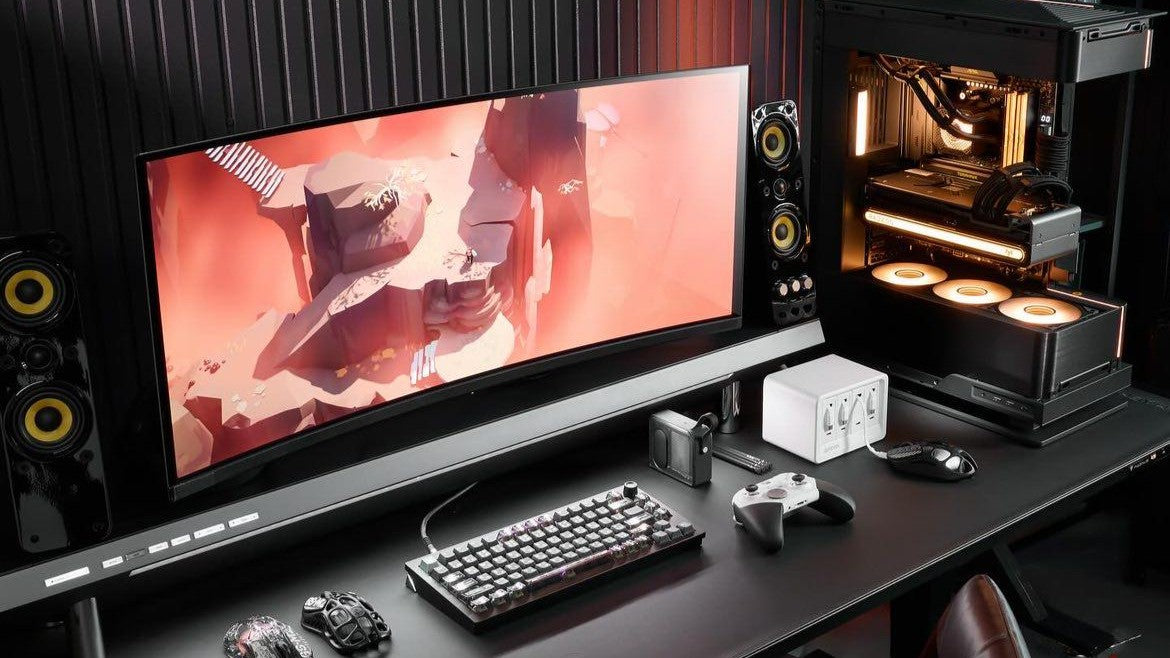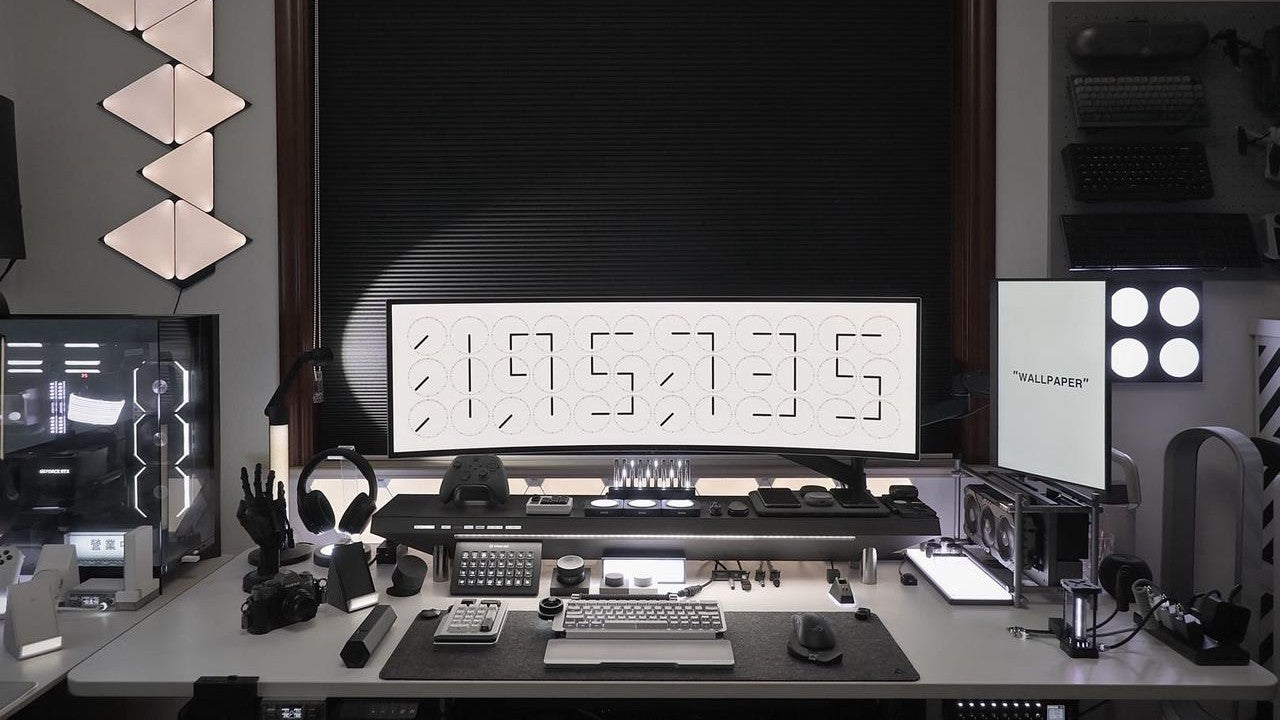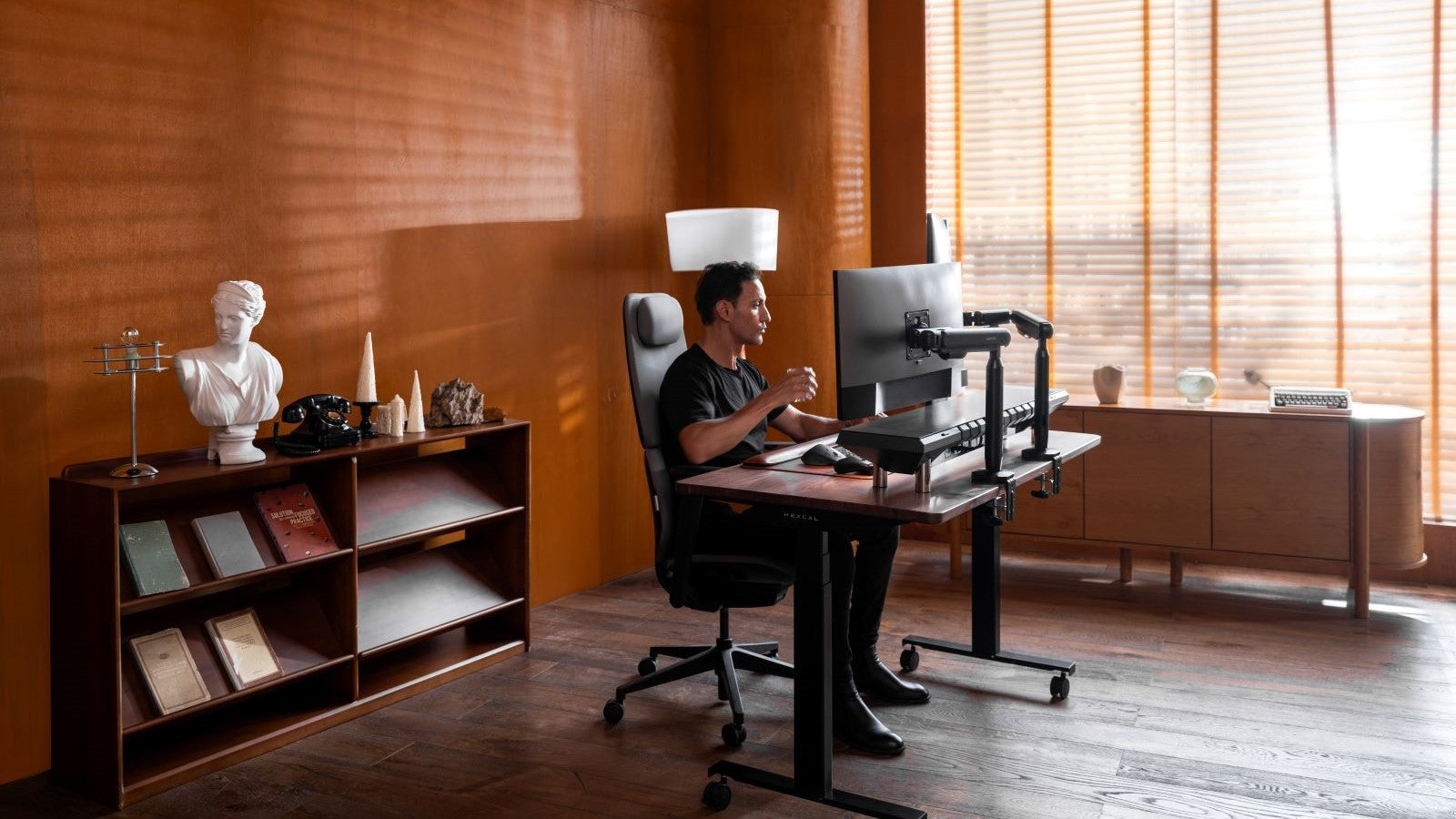Introduction
In 2025, ultrawide monitors are no longer just a niche choice for tech enthusiasts—they’ve become a defining feature of modern desk spaces. An ultrawide monitor is any display with an aspect ratio wider than the standard 16:9 format, most commonly 21:9 or 32:9. This extra width provides more room to work, streamlines multitasking, and creates a cleaner, more immersive setup. For many professionals and gamers, it eliminates the need for a dual-monitor arrangement altogether.
Whether you are a gamer seeking cinematic immersion, a professional juggling multiple apps, or a creator working across expansive project timelines, ultrawide monitors are changing the way we work and play. But to truly unlock their potential, you need more than just the screen itself—you need the right desk, accessories, and workspace design. This guide will walk you through everything you need to know about ultrawide monitors in 2025.

What Is an Ultrawide Monitor?
Ultrawide monitors are defined by their extended aspect ratios—most commonly 21:9 and 32:9—compared to the standard 16:9 displays most people are familiar with. In practice, this means you can see far more horizontal content without scrolling or switching between windows. A 21:9 monitor offers the width of about one and a half standard monitors, while a 32:9 “super ultrawide” delivers the equivalent of two full-sized displays in a single seamless panel.
The benefits of this format extend across different types of users. Gamers enjoy a wider field of view and unmatched immersion in supported titles. Professionals, such as analysts and developers, can spread spreadsheets, browsers, and documentation side by side without the constant interruption of window switching. Creators, from video editors to music producers, find ultrawides invaluable because they can view entire timelines and toolbars at once. The result is a more fluid, focused, and enjoyable workflow.
A Short Timeline of Ultrawide Monitors
Ultrawide monitors first appeared in 2012, when LG introduced the EA93 with a 21:9 aspect ratio. At the time, it was a niche product for early adopters and creative professionals.
The real breakthrough came in 2017 with the launch of 32:9 “super ultrawide” monitors, which replaced two side-by-side displays with a single seamless panel. This eliminated bezels, reduced cable clutter, and created new possibilities for immersive gaming and multitasking.
Since then, ultrawides have rapidly advanced. Between 2019 and 2025, curved screens, OLED technology, and high refresh rates have become standard. Flagship models like the Samsung Odyssey G9 and Neo G9 showcase just how far the format has come—bringing ultrawides firmly into the mainstream.

Choosing the Right Ultrawide Monitor
When it comes to ultrawide monitors, the best choice depends on what you’ll use it for. Each type of user has different needs, and knowing where you fit can help you avoid overpaying for features you don’t need.
If your main goal is productivity, look for a monitor with enough resolution to keep multiple windows open side by side. This makes it easier to work on spreadsheets, compare documents, or keep research and writing in view at the same time.
For gamers, refresh rate is the key feature. A higher refresh rate—like 144Hz or above—makes games look smoother and more responsive. Combined with fast response times and adaptive sync (G-Sync or FreeSync), this ensures you get the most immersive experience.
For creators like designers, video editors, or photographers, color accuracy matters most. Choosing an ultrawide with strong color performance and HDR support will ensure that your work looks exactly as intended, from editing software to final output.
In short, productivity users should focus on screen space, gamers on speed, and creators on color. Once you know which group you fall into, choosing the right ultrawide becomes much simpler.
Tips for Using Ultrawide Monitors:
To get the most out of your ultrawide monitor, keep these tips in mind:
- Match monitor size to desk depth: Larger ultrawides (49" and 57") need more desk space to avoid neck strain. Make sure your desk allows for proper viewing distance.
- Plan cable management early: Ultrawides often connect to multiple devices, which can quickly create clutter. Solutions like the Hexcal Studio help keep cables hidden while providing power to the ultrawide monitors, Plus, it has the same length as the Samsung Odyssey G9, which makes it a great combo.
- Use a strong monitor arm: Ultrawides are heavier and wider than standard monitors. It usually comes with a broad and strong monitor base. If you want to use a monitor arm to create a sci-fi floating effect, a dedicated ultrawide monitor arm, like the Hexcal Heavy Duty Monitor Arm improves ergonomics, saves desk space, and makes it easier to adjust viewing angles.
- Position at eye level – Keep the center of the screen at or slightly below eye height to reduce strain during long hours of work or gaming.
- Pair with a standing desk – Switching between sitting and standing helps reduce fatigue, and an ultrawide monitor works seamlessly with an adjustable workspace.

Ultrawide vs Dual Monitor Comparison
| Característica |
32:9 Súper Ultraancho
|
Monitores duales (2 x 16:9)
|
|
Tamaño típico
|
49"–57"
|
24"–27" cada uno
|
|
Resolución
|
Panel único sin costuras (p. ej., 5120×1440)
|
Dos paneles separados, el ancho total suma (por ejemplo, 2 × 2560 × 1440)
|
|
Ventajas
|
Sin biseles, escritorio más limpio, experiencia inmersiva, gestión de cables más sencilla
|
Tamaño flexible, se pueden combinar tipos de monitores, a menudo un costo total más bajo
|
|
Contras
|
Precio más alto, pesado, requiere un escritorio más profundo, altura vertical limitada
|
Espacio visible en el bisel, más cables para administrar, apariencia menos uniforme
|
|
Usuarios ideales
|
Jugadores, creadores de contenido, usuarios productivos que valoran la inmersión y las configuraciones limpias.
|
Usuarios conscientes del presupuesto, aquellos que prefieren pantallas separadas para diferentes tareas
|
Which should you choose?
If you want immersion and a clean, modern workspace, a super ultrawide is ideal. It eliminates bezels, reduces cable clutter, and creates a seamless experience.
Dual monitors can be a more budget-friendly option because standard 16:9 monitors are mass-produced and widely available, even though you’re buying two units. They’re flexible, letting you mix sizes and resolutions, but the bezel gap and extra cables make them less seamless than a single ultrawide.
With a proper monitor arm and good cable management, ultrawides can become the centerpiece of a streamlined, ergonomic workspace.
Recommended Ultrawide Monitors in 2025
Choosing the right ultrawide monitor depends on your workspace, budget, and intended use. Here are some of the top options in 2025 that combine performance, design, and reliability:
- Samsung Odyssey G9 (49", 32:9)
The Odyssey G9 remains a benchmark for super ultrawides. With its 5120×1440 resolution, 240Hz refresh rate, and 1000R curvature, it offers an immersive experience for both gaming and productivity. Its seamless wide panel makes it perfect for multitasking or creative workflows that benefit from extra horizontal space.
- LG 34WN80C-B (34", 21:9)
This 34-inch ultrawide strikes a balance between performance and affordability. It features USB-C connectivity, which makes it ideal for professionals who need a clean setup with minimal cables. Its high resolution and accurate colors also make it suitable for creators and office work.
- Dell U4924DW (49", 32:9)
Tailored for productivity, this super ultrawide offers ample screen real estate with strong color accuracy. Its large curved panel helps reduce the need for multiple monitors, while built-in features like PBP (Picture-by-Picture) support users who still want to manage multiple inputs efficiently.
- AOC CU34G3S (34", 21:9)
A solid option for gaming on a budget, the CU34G3S combines a fast refresh rate with a curved screen and wide color range. It’s perfect for users who want a more immersive experience without investing in a premium super ultrawide.
Final Thoughts – Build the Perfect Ultrawide Setup
An ultrawide monitor can completely transform the way you work or play, but its benefits depend on how it’s set up. Choosing the right size and resolution, arranging your desk properly, and positioning the screen at an ergonomic height all contribute to a more comfortable and productive workspace.
With careful planning, an ultrawide setup can reduce distractions, eliminate the need for multiple monitors, and give you plenty of space for multitasking. Gamers can enjoy immersive gameplay, professionals can manage multiple apps without constant window switching, and creators can see timelines or projects in full view.
Ultimately, a thoughtful ultrawide setup isn’t just about adding more pixels—it’s about enhancing efficiency, improving comfort, and creating a workspace that looks and feels modern. When you combine these elements, your desk becomes a place where you can focus, create, and perform at your best.
FAQ
An ultrawide monitor is a display with a wider aspect ratio than the standard 16:9, most commonly 21:9 or 32:9. This extra width provides more horizontal screen space, allowing you to view multiple windows side by side, improve multitasking, and create a more immersive experience for gaming, creative work, or productivity.
It depends on your workflow. Ultrawides provide a seamless, bezel-free workspace, which can improve focus and make multitasking easier. Dual monitors offer flexibility, allowing you to mix different screen sizes or resolutions and adjust them independently. For many users, an ultrawide reduces cable clutter and creates a cleaner setup, while dual monitors can be more budget-friendly.
Cable management is essential for ultrawides since they often connect to multiple devices. Strategies include using cable trays, clips, or sleeves to keep cords organized and out of sight. You can also choose premium products such as Hexcal Studio for better desk power supply and organization. Planning your connections in advance and minimizing unnecessary cables can help maintain a clean and efficient workspace.
Yes. Because ultrawides are wider and heavier than standard monitors, a regular monitor arm may not provide enough support. A specialized ultrawide monitor arm is designed to safely hold the extra weight and width while allowing for proper ergonomic adjustments.
Yes. macOS supports ultrawide resolutions and can take advantage of the extra horizontal space for multitasking. Features like Mission Control and Split View make it easy to organize windows across the wider screen. However, some apps may not be optimized for very wide aspect ratios, so it’s worth checking software compatibility if you rely heavily on specific programs.





